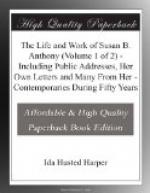Mrs. Stanton wrote shortly afterwards, urging her to come to Seneca Falls: “Indeed it would do me great good to see some reformers just now. The death of my father, the worse than death of my dear cousin Gerrit,[28] the martyrdom of that great and glorious John Brown, all conspire to make me regret more than ever my dwarfed and perverted womanhood. In times like these every soul should do the work of a fullgrown man. When I pass the gate of the celestials and good Peter asks me where I wish to sit, I will say: ’Anywhere so that I am neither a negro nor a woman. Confer on me, great angel, the glory of white manhood, so that henceforth I may feel unlimited freedom.’”
In this year of 1859, Charles F. Hovey, a wealthy merchant of Boston, a radical in religion and a noted reformer and philanthropist, left $50,000 to be expended in securing equal rights for women, the abolition of slavery, and other reforms, at the discretion of Wendell Phillips, Wm. Lloyd Garrison and the other executors. As slavery was abolished four years later, a considerable portion of this was used for the cause of woman.
Early in December the anti-slavery committee insisted that Miss Anthony should resume the management of their conventions, as they wished to hold a series throughout the large cities of the State and had been unable to find any one who could so successfully conduct them. Abby Kelly Foster, though often critical and censorious, wrote her regarding one of her speeches: “It is a timely, noble, clear-sighted and fearless vindication of our platform. I want to say how delighted both Stephen and myself are to see that you, though much younger than some others in the anti-slavery school, have been able to appreciate so entirely the genius of our enterprise.” The distinguished George B. Cheever, of the Church of the Puritans in New York, one of the few orthodox clergymen who stood with the Abolitionists in those early days, wrote Miss Anthony: “May God be with you and guide and bless you in your efforts. That is the strength we all need and must have if we accomplish anything good and permanent in this terrible conflict.”
[Autograph: George B. Cheever]
A single instance will show how closely the question of woman’s rights was connected with that of anti-slavery in the popular mind. When Miss Anthony and Mrs. Blackwell were at Fort William Henry, at the head of Lake George, they spoke one evening in the hotel parlors. There were a number of southerners present and many of them were delighted with the meeting, whose doctrines were entirely new to them, and made liberal contributions. The next day the speakers left in the stage with one of these, Judge John J. Ormond and his two daughters, of Tuscaloosa, Ala. He told Miss Anthony he had been instrumental in securing many laws favorable to women in that state and it would be a pleasure to him to see that their memorial was presented to the Alabama Legislature. When she reached home she sent it to him with the following letter:




